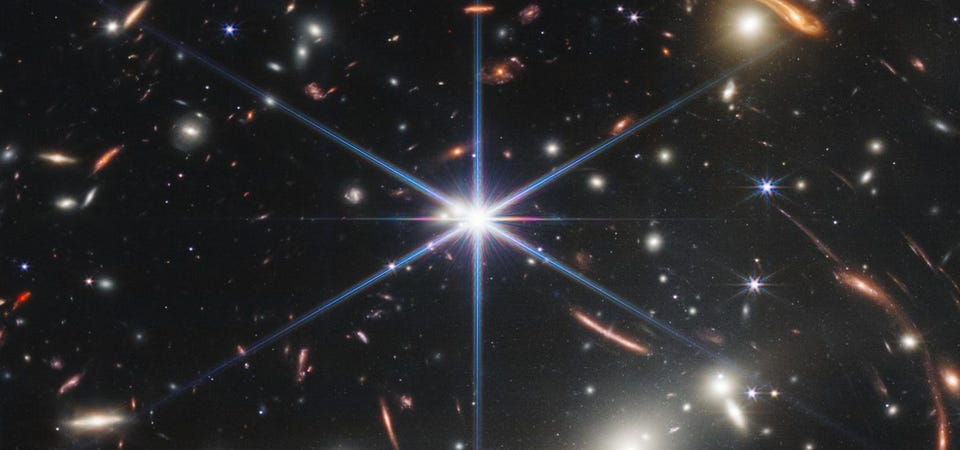Science Why Do The Stars In The Webb Telescope’s First Images Have Eight Weird ‘Snowflake’ Spikes? Jamie Carter Senior Contributor Opinions expressed by Forbes Contributors are their own. I inspire people to go stargazing, watch the Moon, enjoy the night sky New! Follow this author to improve your content experience. Got it! Jul 19, 2022, 08:00pm EDT | Share to Facebook Share to Twitter Share to Linkedin Galaxy cluster SMACS 0723, known as Webb’s First Deep Field, features “spiky” stars and even .
. . [+] galaxies.
NASA, ESA, CSA, STScI, Webb ERO Did you have the same question as I did when you looked at the spectacular first light images from the $10 billion James Webb Space Telescope (JWST or “Webb” for short)? Yes, they are all incredible, and a week later I’ve spent more hours than I can justify staring at, and zooming in on, Webb’s amazing images. However, I couldn’t help but notice—and be increasingly distracted by—the oddness of the spiky stars in Webb’s images. Every single star has six very clear, very bright and very uniform spikes—just like a snowflake.
Look more carefully and you’ll see that there are two more smaller spikes on the horizontal. The brighter the star, a bigger and more distracting the spikes. Even galaxies have a spikiness in Webb’s images.
NASA, ESA, CSA, and STScI Although the phenomenon is only immediately noticeable with stars, look carefully at the galaxies in the hi-res version of the incredible Webb deep field image (main image, above) and you’ll see that even galaxies have these spikes. What’s going on? It’s all down to the physical design of Webb—and its engineers knew the “spiky” stars would be the result. MORE FOR YOU New Research Finds A Connection Between Domestic Violence And These Two Personality Disorders This Scientist Helps Andean Forests And Ecuador’s Women In STEM Exceptional Fossil Preservation Suggests That Discovering Dinosaur DNA May Not Be Impossible What kind of telescope is Webb? Webb is a reflecting telescope of the kind invented by Isaac Newton in the 17th century, only much, much larger.
Reflecting telescopes use primary mirrors to reflect light to form an image on a secondary mirror situated in front. Webb’s primary mirror In Webb’s case its primary mirror has a diameter of 21 feet/6. 5 meters and, crucially, comprises 18 gold-plated beryllium hexagonal mirror segments.
Hexagonal = six-sided. It looks like this: The James Webb Space Telescope (JWST or Webb), has a primary mirror made from 18 hexagonal segments. .
. . [+] getty Webb’s secondary mirror See those three struts in front of the primary mirror, above? They support the secondary mirror—where the light from those 18 mirrors that comprise the primary mirror is focused.
The two lower structs are angled specifically so they’re 150º from the top strut. That’s crucial for understanding the spikes. Here’s why.
Webb’s two sets of ‘diffraction spikes’ Diffraction spikes from the primary mirror Webb’s physical construction causes two sets of spikes that purposefully overlap. The hexagonal shape of the 18 mirrors that make up the primary mirror were always going to cause six-sided spiky stars. That’s because light travels as a wave, and when it comes up against a boundary, it’s redirected and sent off in a different direction.
That’s diffraction. So the hexagonal shape of the primary mirror segments was always going to mean that all stars in Webb’s images would have six diffraction spikes. Diffraction spikes from the struts As the light gathered by those 18 hexagonal segments is reflected onto the secondary mirror sitting in front of it, it hits the struts that support it.
As it does it creates a diffraction spike perpendicular to each strut, which together form six more diffraction spikes. This illustration demonstrates the science behind Webb’s diffraction spike patterns, showing how . .
. [+] diffraction spikes happen, the influence of the primary mirror and struts, and the contributions of each to Webb’s diffraction spikes. NASA, ESA, CSA, Leah Hustak (STScI), Joseph DePasquale (STScI) How Webb’s diffraction spikes overlap Although the diffraction spikes caused by the struts are smaller and less noticeable than those created by the primary mirror, Webb’s engineers cleverly angled the struts so that the resulting diffraction spikes would overlap.
So while the struts do create six-sided diffraction spikes, four of them overlap with four previously created by the primary mirror. Only the two horizontal spikes do not overlap. The result is that all stars in the Webb telescope’s images have eight points—something that’s already a trademark that sets it apart from, say, Hubble’s images, which have four diffraction spikes.
This side-by-side comparison shows observations of the Southern Ring Nebula in near-infrared light, . . .
[+] at left, and mid-infrared light, at right, from NASA’s Webb Telescope. NASA, ESA, CSA, STScI, and The E Why stars in Webb’s images won’t always look spiky Look at the images above of the Southern Ring Nebula. The right-hand image was taken with Webb’s Near-Infrared Camera (NIRCam) instrument while the left-hand image used the Mid-Infrared Instrument (MIRI) image.
You can see that only the NIRCam image has really bright “spiky” stars. Why? “In near-infrared light, stars have more prominent diffraction spikes because they are so bright at these wavelengths,” said the Space Telescope Science Institute. “In mid-infrared light, diffraction spikes also appear around stars, but they are fainter and smaller.
” For now Webb’s “spiky stars” in its NIRCam images are slightly distracting, but just like the higher resolution, more detailed images it produces, it’s something we’ll all quickly get used to seeing. Wishing you clear skies and wide eyes. Follow me on Twitter or LinkedIn .
Check out my website or some of my other work here . Jamie Carter Editorial Standards Print Reprints & Permissions.
From: forbes
URL: https://www.forbes.com/sites/jamiecartereurope/2022/07/19/why-do-the-stars-in-the-webb-telescopes-first-images-have-eight-weird-snowflake-spikes/
